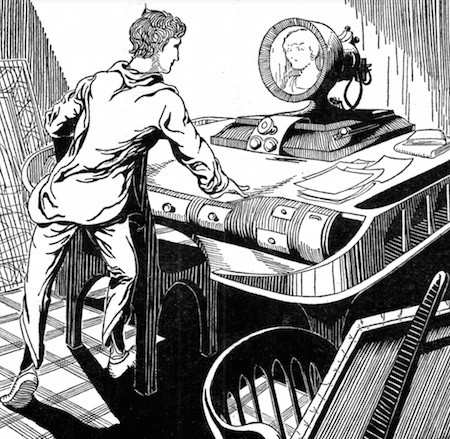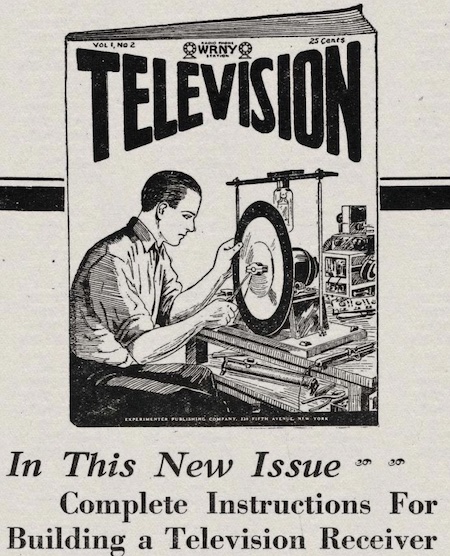Science Fiction
Dictionary
A B C D E F G H I J K L M N O P Q R S T U V W X Y Z
Latest By
Category:
Armor
Artificial
Intelligence
Biology
Clothing
Communication
Computers
Culture
Data Storage
Displays
Engineering
Entertainment
Food
Input Devices
Lifestyle
Living Space
Manufacturing
Material
Media
Medical
Miscellaneous
Robotics
Security
Space Tech
Spacecraft
Surveillance
Transportation
Travel
Vehicle
Virtual
Person
Warfare
Weapon
Work
"I wrote many novels which … contained the element of the projected collective unconscious, which made them simply incomprehensible to anyone who read them, because they required the reader to accept my premise that each of us lives in a unique world."
- Philip K. Dick
| Videophone | ||
| A person-to-person communication device offering sight as well as sound. |
As far as I know, the first use of this word in science fiction. However, the idea had been described several times in earlier works; see below.
| On his desk there reposed an instrument comprising
a disc of silvery gray metal, framed in darker gray,
and mounted vertically upon a base of similar material.
This instrument was Roy’s private videophone, and it
was the calls from it of a voice repeating, “NY-19-635,”
that occasioned his numerous returns to it. As he
returned and answered his number, a face would appear
in the disc and inform him in a monotonous voice that
no success could as yet be reported on his call. Each
time this was a signal for his renewal of the nervous
pacing and muttering, accompanied by further rumpling of his hair.
 (Videophone by Harl Vincent) It was preposterous! Here he had been trying for two hours to get a connection with one of his patrons in Paris. Constant reports there had been that something was wrong with the continental video. Pity that the Terrestrial Videophone Company couldn’t keep their confounded voice and vision ether waves working, he thought angrily. Or whatever kind of waves they were! Roy was no scientist. |
| Technovelgy from The Golden Girl of Munan,
by Harl Vincent. Published by Amazing Stories in 1928 Additional resources -
|
Harl Vincent made good use of this new expression in his 1929 story War of the Planets:
“Connections have now been established with the great reflector at Castle Mountain. If you darken your rooms, you will find that the newly discovered phenomenon is dimly visible in the disc of your instrument.’’
Walter switched off the lights and drew two chairs close to the videophone.
Thelda joined him there and the two gazed intently at the disc.
The view was very indistinct at first, but, as their eyes became accustomed to the darkness, a small group of weird objects became visible in the center of the disc...
At this juncture their individual call sounded from the videophone and Walter flipped back the news lever to permit the incoming personal call to be made. The disc flashed brightly and the face of his father appeared.
“Hello, folks,” spoke the cheery voice of the man they both loved, “Why in the world are you sitting in the darkness? Oh. I know — you have been listening to the absurd reports of some menace from the skies...
"All right, dear. I’ll be home in ten minutes, but I’m afraid we’re going to have to keep an eye on that son of ours this evening,” grinned Roy, “So long.”
The disc went dark and the voice was gone.
A videophone could also have a huge screen so many could see, again from The War of the Planets:
In case you're wondering why videophones had a circular screen, it's because the mechanical scan version of television technology of the Twenties made use of a disc:
At that moment the news announcer’s voice burst forth from the videophone:
They found the southbound moving ways unusually jammed for the time of day and a holiday spirit prevailed. Everyone wore a smile and the names of Roy Hamilton and Professor Nilsson were on the lips of all. They left the moving platform at 125th crossing and mingled with the crowd in Square T-17 on the sixth level. Here was a huge videophone screen, fully thirty feet in diameter, and the voice of a news announcer filled the entire area with natural distinctness, but amplified to such an extent that it completely overcame the crowd noises. Still it was not painful to the ear, but seemed rather to come from a point immediately adjacent to the individual listener in ordinary speaking volume, The scene in the disc was again that through the Castle Mountain reflector and the three women thrilled with secret pride as they watched the drifting, weaving convolutions of the approaching fleet and realized that their men had recently left the vicinity of the menacing mass with a victory to their credit.

(1929 advertisement)
A.E. van Vogt used this same term in 1945 in The World of Null-A:
He closed the door, fastened the three plasto-windows and put a tracer on his videophone.
Not to be outdone, Philip K. Dick, shortens it and makes it more mobile in his 1955 story War Veteran:
LeMarr dropped a coin in the vidphone mounted on the dash-board. He gave the hospital number, and when the monitor appeared, asked hoarsely for Vachel Patterson.
FCompare to the detailed article about the telephonoscope from Le Vingtième Siècle (The Twentieth Century) (1882) by Albert Robida, the phonotelephote from In the Year 2889 (1889) by Jules Verne, the telephot from Ralph 124c 41 + (1911) by Hugo Gernsback, the video communicator from The Machine Stops (1909) by E.M. Forster, the zoom call visaphone system from John Jones's Dollar (1915) by Harry Stephen Keeler, the optophone from Too Many Boards! (1931) by Harl Vincent and the opti-phone from The Impossible World (1939) by Eando Binder.
Comment/Join this discussion ( 0 ) | RSS/XML | Blog This |
Additional
resources:
More Ideas
and Technology from The Golden Girl of Munan
More Ideas
and Technology by Harl Vincent
Tech news articles related to The Golden Girl of Munan
Tech news articles related to works by Harl Vincent
| Huawei Pura X Folding Phattie Phone |
| Positioned Cybertrucks With Free Starlinks WiFi In LA |
| Will Whales Be Our First Contact? |
| NYC/Dublin Portal Fails To Meet 'Guardian Of Forever' Standards |
Want to Contribute an
Item?
It's easy:
Get the name of the item, a
quote, the book's name and the author's name, and Add
it here.
| <Previous | Next> |
|
|
|
Technovelgy (that's tech-novel-gee!) is devoted to the creative science inventions and ideas of sf authors. Look for the Invention Category that interests you, the Glossary, the Science Fiction Invention Timeline, or see what's New.
|
Science Fiction
Timeline
1600-1899
1900-1939
1940's 1950's
1960's 1970's
1980's 1990's
2000's 2010's
'Power could be compressed thus into an inch-square cube of what looked like blue-white ice'
'It's so light that you can set it up in five minutes by yourself...'
'Heavy penalties... were to be applied to any one found driving manually-controlled machines.'
'Buy a Little Dingbat... electropen, wrist watch, pocketphone, pocket radio, billfold ... all in one.'
'... an elastic, tinted material that had all the feel and appearance of human flesh and epidermis.'
'It is remarkable that the long leverages of their machines are in most cases actuated by a sort of sham musculature...'
